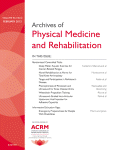 This observational retrospective multicenter cohort study aimed to assess the ability of the Motor Function Measure (MFM) to detect changes in the progression of spinal muscular atrophy (SMA). Seventeen departments of paediatric physical medicine were involved in this study that recruited 112 volunteer SMA patients aged 5.7 to 59 years with no other treatment than physical therapy and nutritional or respiratory assistance. The distributions of the MFM scores (total score and 3 subscores) were analysed per SMA subtype. The relationships between scores and age were studied. The slopes of score changes (reflecting MFM responsiveness) were estimated in patients with at least six months follow-up and two MFMs. Hypothetical sample sizes for specific effect sizes in clinical-trial scenarios are given. In 12 SMA Type 2 and 19 SMA Type 3 patients (mean/SD follow-up: 25.8/19 months), there was a moderate inverse relationship between age and the MFM total score. Patients with less than 6 months follow-up showed little score changes. Patients with longer follow-ups showed a slow deterioration (-0.9 points/year for Type 2 and -0.6 points/year for Type 3). Substantial responsiveness was obtained with MFM D2 subscore (proximal and axial motricity) in Type 2 (Standardized response mean, SRM=1.29) and MFM D1 subscore (standing and transfers) in Type 3 patients aged 10-15 years (SRM=0.94). If further confirmed by larger studies, these preliminary results on the relative responsiveness of the MFM in SMA will foster its use in monitoring disease progression in patients who participate in clinical trials.
This observational retrospective multicenter cohort study aimed to assess the ability of the Motor Function Measure (MFM) to detect changes in the progression of spinal muscular atrophy (SMA). Seventeen departments of paediatric physical medicine were involved in this study that recruited 112 volunteer SMA patients aged 5.7 to 59 years with no other treatment than physical therapy and nutritional or respiratory assistance. The distributions of the MFM scores (total score and 3 subscores) were analysed per SMA subtype. The relationships between scores and age were studied. The slopes of score changes (reflecting MFM responsiveness) were estimated in patients with at least six months follow-up and two MFMs. Hypothetical sample sizes for specific effect sizes in clinical-trial scenarios are given. In 12 SMA Type 2 and 19 SMA Type 3 patients (mean/SD follow-up: 25.8/19 months), there was a moderate inverse relationship between age and the MFM total score. Patients with less than 6 months follow-up showed little score changes. Patients with longer follow-ups showed a slow deterioration (-0.9 points/year for Type 2 and -0.6 points/year for Type 3). Substantial responsiveness was obtained with MFM D2 subscore (proximal and axial motricity) in Type 2 (Standardized response mean, SRM=1.29) and MFM D1 subscore (standing and transfers) in Type 3 patients aged 10-15 years (SRM=0.94). If further confirmed by larger studies, these preliminary results on the relative responsiveness of the MFM in SMA will foster its use in monitoring disease progression in patients who participate in clinical trials.
